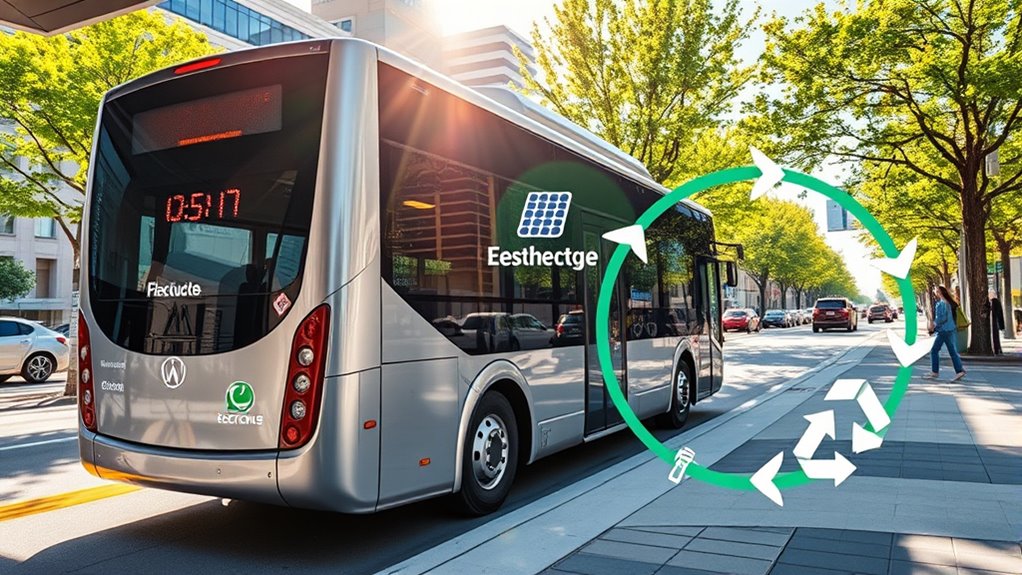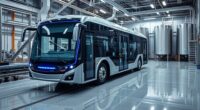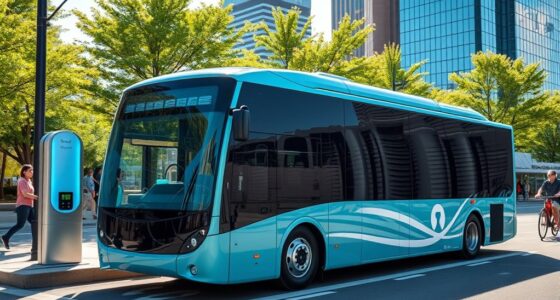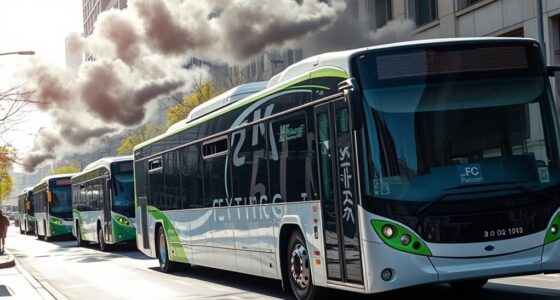A Life Cycle Assessment of electric buses looks at their environmental impacts from raw material extraction to disposal, helping you understand their true sustainability. It shows that while electric buses reduce operational emissions, manufacturing, especially batteries, can have significant impacts. Advances in battery technology and recycling are improving their overall footprint. If you keep exploring, you’ll discover how these innovations make electric buses a greener choice over their lifespan.
Key Takeaways
- LCA evaluates environmental impacts of electric buses across manufacturing, operation, and disposal stages.
- Battery production and recycling significantly influence overall lifecycle impacts.
- Electric buses generally reduce operational emissions, especially when powered by renewable energy.
- Extending bus lifespan and improving battery technology enhance sustainability benefits.
- LCA helps compare environmental benefits of electric versus diesel buses throughout their entire life cycle.
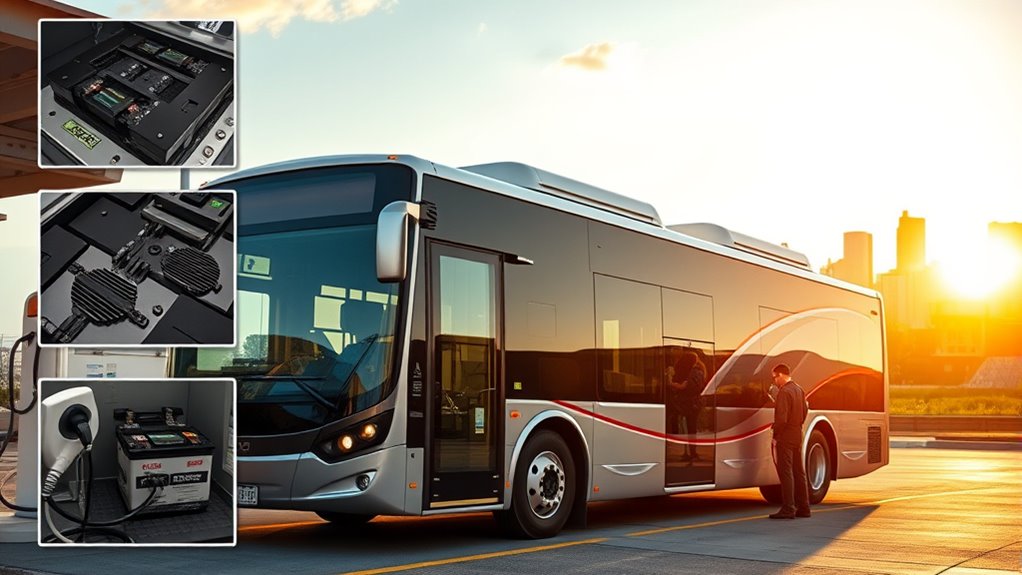
Have you ever wondered how environmentally friendly electric buses really are throughout their entire lifespan? That’s where a tool called Life Cycle Assessment (LCA) comes into play. LCA is a thorough method used to evaluate the environmental impacts of products—from raw material extraction to disposal or recycling at the end of their life. When applied to electric buses, it helps you understand the full picture, not just their emissions during operation but also the impacts of manufacturing and disposal. This makes LCA an essential tool for companies like Volvo Buses and Ebusco, who aim to minimize their environmental footprint.
By comparing electric and traditional diesel buses, LCA provides clarity on which option truly offers the better environmental outcome. In the bus industry, LCA serves multiple purposes. It offers stakeholders a detailed view of the environmental implications of switching to electric models. You’ll see how factors like energy consumption, emissions, and material use stack up across the entire life cycle.
LCA clarifies the true environmental benefits of electric versus diesel buses across their entire life cycle.
This information helps public transport authorities choose the most sustainable options, considering everything from manufacturing to end-of-life recycling. For instance, during manufacturing, the production of batteries and other components can have substantial environmental impacts, but the assessment also weighs these against the benefits gained during operation. By evaluating different powertrain options, LCA plays an indispensable role in planning sustainable transportation systems.
When it comes to environmental impact categories, LCA considers human health, ecosystem quality, climate change, and resource depletion. Studies reveal that while electric buses drastically cut emissions during their operational phase, their production—especially battery manufacturing—can have higher impacts. The overall benefit depends heavily on the energy sources used to charge the buses and the technology behind their batteries.
LCA helps identify areas for improvement, such as optimizing battery size and chemistry to reduce environmental impacts. When powered by renewable energy, electric buses tend to outperform traditional models considerably, making their environmental advantages even clearer. Additionally, advancements in battery technology are continuously reducing the environmental footprint of electric buses, further enhancing their sustainability profile.
Battery technology plays a prominent role in the environmental profile of electric buses. Different types and sizes of batteries influence the overall impact. Lithium-ion batteries are common, but their environmental footprint varies based on size, chemistry, and how long they last. Manufacturing processes for batteries also significantly contribute to their lifecycle impacts, highlighting the importance of sustainable practices. Innovations in recycling methods can further reduce waste and resource consumption associated with battery disposal.
Extending the bus’s lifespan from 10 to 20 years can distribute the initial impacts of production, improving sustainability. Recycling and second-life applications for batteries also help lessen environmental impacts, and LCAs often highlight these opportunities. For example, lighter buses like Ebusco’s 3.0 model aim to reduce energy consumption, further lowering the carbon footprint over the vehicle’s life. Moreover, the integration of innovative recycling processes can significantly reduce the lifecycle impacts of batteries, making electric buses even more environmentally sustainable.
Frequently Asked Questions
How Do Electric Buses Compare Cost-Wise Over Their Lifespan?
You’re wondering how electric buses stack up financially over their lifespan. While they cost more upfront, they save substantially on fuel and maintenance costs, especially on high-mileage routes.
Payback periods vary, but electric buses often become cost-effective within 8-17 years. Factors like utilization rates, energy prices, and government subsidies influence overall costs, making electric buses a smart long-term investment if used intensively.
What Are the Challenges in Recycling Electric Bus Batteries?
You face several challenges in recycling electric bus batteries. The lack of standardized processes and specialized facilities makes recycling complex and costly.
Different chemistries require unique techniques, and extracting valuable materials is technically tough.
Economic factors like high recycling costs and limited incentives also hinder progress.
Additionally, environmental risks from toxic leaks and the need for better awareness and regulations complicate establishing efficient, sustainable recycling systems.
How Does the Source of Electricity Affect the Environmental Benefits?
The source of electricity considerably impacts your electric bus’s environmental benefits. If you charge with coal or gas, your emissions are reduced but still substantial, lowering the advantage by 30-50%.
Using renewable energy, like solar or wind, makes your bus nearly emission-free, maximizing climate benefits.
As grids become cleaner over time, your electric bus’s environmental impact improves, helping you contribute more effectively to reducing overall greenhouse gases.
Are Electric Buses Suitable for Long-Distance Routes?
You wonder if electric buses work for long-distance routes. With ranges up to 550 km and large battery capacities, they can handle most suburban trips if managed well.
Efficient drivers and charging strategies, like opportunity charging at stops, extend their reach. Plus, improved battery tech and infrastructure upgrades make them increasingly suitable for longer distances.
They offer a sustainable alternative to diesel buses while reducing emissions and operational costs.
What Policies Can Promote Sustainable Electric Bus Adoption?
To promote sustainable electric bus adoption, you should leverage policies like purchase grants and subsidies to lower initial costs.
Invest in charging infrastructure and offer reduced electricity rates to support operations.
Implement low-interest loans and tax incentives to make financing easier.
Set clear emissions standards and sustainability goals, encouraging early adoption through targeted incentives.
Collaborating with private sectors and aligning with public transportation strategies can further accelerate the progression to cleaner, sustainable bus fleets.
Conclusion
By now, you see that electric buses substantially reduce emissions over their lifetime, with a typical life cycle emitting up to 40% less greenhouse gases than diesel counterparts. This means your choice to support electric buses can greatly benefit the environment. Considering that the production phase accounts for about 20% of total emissions, improving manufacturing can make them even greener. So, next time you ride, remember you’re helping create a cleaner, more sustainable future.
